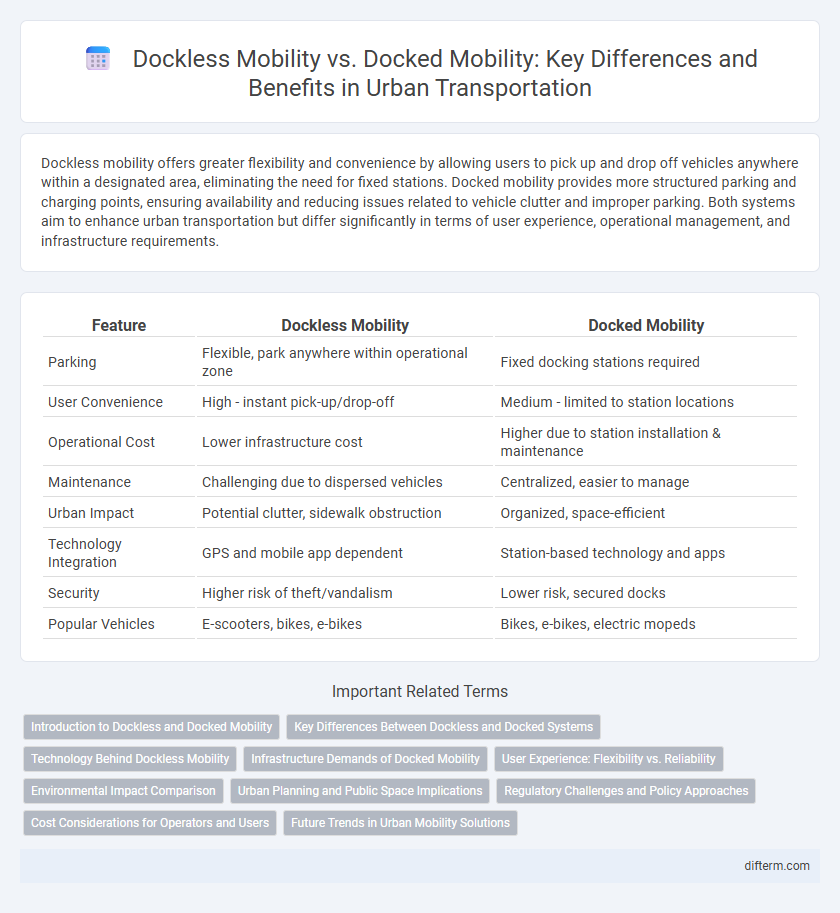Dockless mobility offers greater flexibility and convenience by allowing users to pick up and drop off vehicles anywhere within a designated area, eliminating the need for fixed stations. Docked mobility provides more structured parking and charging points, ensuring availability and reducing issues related to vehicle clutter and improper parking. Both systems aim to enhance urban transportation but differ significantly in terms of user experience, operational management, and infrastructure requirements.
Table of Comparison
| Feature | Dockless Mobility | Docked Mobility |
|---|---|---|
| Parking | Flexible, park anywhere within operational zone | Fixed docking stations required |
| User Convenience | High - instant pick-up/drop-off | Medium - limited to station locations |
| Operational Cost | Lower infrastructure cost | Higher due to station installation & maintenance |
| Maintenance | Challenging due to dispersed vehicles | Centralized, easier to manage |
| Urban Impact | Potential clutter, sidewalk obstruction | Organized, space-efficient |
| Technology Integration | GPS and mobile app dependent | Station-based technology and apps |
| Security | Higher risk of theft/vandalism | Lower risk, secured docks |
| Popular Vehicles | E-scooters, bikes, e-bikes | Bikes, e-bikes, electric mopeds |
Introduction to Dockless and Docked Mobility
Dockless mobility systems allow users to access shared vehicles like bikes or scooters without relying on fixed docking stations, enhancing flexibility and urban coverage. Docked mobility requires vehicles to be picked up and returned at designated stations, ensuring organized parking and simplified maintenance. Each model impacts urban mobility patterns, infrastructure demands, and user convenience differently.
Key Differences Between Dockless and Docked Systems
Dockless mobility systems offer flexible vehicle access without fixed stations, allowing users to pick up and drop off bikes or scooters anywhere within a designated area, enhancing convenience and coverage. Docked systems require vehicles to be returned to specific docking stations, ensuring organized parking and reducing street clutter but limiting user flexibility and trip options. Key differences include vehicle distribution management, user convenience, and infrastructure dependency, with dockless systems demanding advanced GPS and geofencing technologies for real-time tracking.
Technology Behind Dockless Mobility
Dockless mobility relies on GPS, IoT sensors, and AI-powered algorithms to enable real-time vehicle tracking, dynamic fleet management, and user-friendly app interfaces. This technology supports flexible pick-up and drop-off locations, enhancing urban accessibility without the need for fixed docking stations. Machine learning optimizes vehicle distribution and maintenance schedules, reducing operational costs and improving service efficiency.
Infrastructure Demands of Docked Mobility
Docked mobility systems require extensive infrastructure investments including fixed docking stations strategically placed throughout urban areas, demanding significant space allocation and ongoing maintenance. These docking stations facilitate organized vehicle storage and charging but limit flexibility in vehicle accessibility and deployment. The increased infrastructure costs and spatial requirements often make docked mobility less adaptable compared to dockless systems in rapidly changing urban environments.
User Experience: Flexibility vs. Reliability
Dockless mobility offers users unparalleled flexibility by allowing spontaneous pick-up and drop-off anywhere within the service area, enhancing convenience for short, unpredictable trips. Docked mobility ensures higher reliability with fixed stations that provide consistent availability and secure parking, reducing the risk of misplaced vehicles or service interruptions. Users prioritize flexibility in dynamic urban environments while valuing the predictability and order that docked systems deliver.
Environmental Impact Comparison
Dockless mobility systems significantly reduce the need for physical docking stations, leading to less urban infrastructure and lower material consumption compared to docked mobility. However, dockless vehicles often face challenges with increased repositioning trips and improper parking, which can elevate energy use and generate additional waste. Studies indicate that while docked mobility offers more controlled deployment reducing environmental degradation, dockless solutions promote higher accessibility that can potentially decrease reliance on private cars, contributing to lower overall carbon emissions.
Urban Planning and Public Space Implications
Dockless mobility systems offer flexible access and reduce the need for fixed infrastructure, but their unmanaged parking often leads to cluttered sidewalks and obstructed pedestrian pathways. Docked mobility requires dedicated stations that organize device placement, preserving public space but limiting operational range and access convenience. Urban planners must balance these trade-offs by integrating dockless systems with clear regulations and strategically placing docks to maintain public space usability and pedestrian safety.
Regulatory Challenges and Policy Approaches
Dockless mobility systems face significant regulatory challenges including issues with public space management, safety standards, and inconsistent local policies that complicate integration into urban transport networks. In contrast, docked mobility often benefits from clearer regulatory frameworks due to fixed stations that facilitate monitoring and compliance. Effective policy approaches for dockless mobility emphasize flexible regulations, stakeholder collaboration, and technology-driven solutions to balance innovation with community impact and operational control.
Cost Considerations for Operators and Users
Dockless mobility systems often reduce infrastructure expenses for operators by eliminating the need for fixed docking stations, lowering initial capital investment. Users benefit from flexible pick-up and drop-off locations, which can decrease indirect costs such as time and convenience fees. However, docked mobility typically incurs higher operational maintenance costs due to station upkeep but may offer more predictable revenue streams through consistent user access points.
Future Trends in Urban Mobility Solutions
Dockless mobility solutions offer enhanced flexibility and accessibility by allowing users to pick up and drop off vehicles at any location, which supports dynamic urban environments and reduces reliance on fixed infrastructure. Docked mobility systems, while providing structured parking and better vehicle management, face limitations in scalability and convenience compared to dockless models. Future urban mobility trends emphasize integrating AI-driven data analytics and IoT connectivity to optimize hybrid models that balance dockless freedom with docked stability, enhancing overall transportation efficiency and sustainability.
dockless mobility vs docked mobility Infographic

 difterm.com
difterm.com